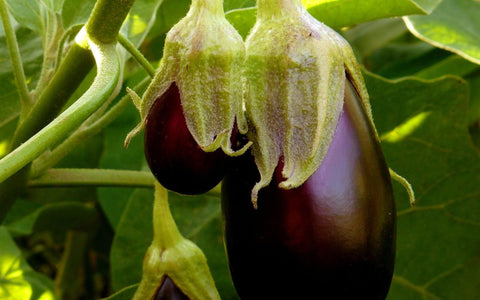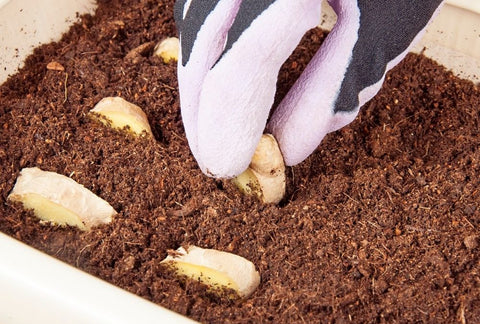Did you know? Eggplants are botanically considered berries, like watermelon, blueberries, and tomatoes. Yet at the same time, they’re considered a vegetable in gastronomy. In this blog, we’ll be talking about growing eggplant indoors, from basic facts, supplies, setup, and steps to grow, care for, and harvest it.
|
Plant type |
Perennial grown as annual |
|
Family |
Solanaceae |
|
Binomial name |
Solanum melongena |

Timing
Eggplant sprouts in 1-2 weeks and it can be harvested from Month 3 on.

Part sun
Growing eggplant indoors needs an equivalent of 7+ hours of direct sun [DLI of 21+ mol/m²/day].

Care
Growing eggplant indoors is for intermediate gardeners. You’ll sprout, thin, prune, and pollinate.
TABLE OF CONTENTS
Ways to Grow Eggplant | Care and Maintenance for Eggplant | Timeline & Steps | Cultivars/Varieties
Ways to Grow Eggplant Indoors
Growing Eggplant Indoors Using Soil vs Hydroponics
Growing Eggplant Indoors Using Soil
Eggplants do well in moist soil conditions. If the soil dries out completely, the roots will die back, making it tough for the plant to recover. At the same time, if the roots are exposed to standing water for too long, they can rot.
Growing Eggplant Indoors Using Hydroponics
Yes, eggplants can be grown using hydroponic systems. However, they take longer to harvest compared to herbs, as we harvest their fruits instead of their leaves, and these won’t show until after 80-90 days.
Equipment Needed for Growing Eggplant Indoors Using Soil
We prefer using a Ceramic Self-Watering Planter filled with a standard potting mix that self-regulates to keep the soil at consistent moisture for your plant to thrive (and no watering guesswork for you).
To set one up:

- Fill up the planter with dry soil from the bag, gently tamping down the top.
- Dump the soil into a large mixing bowl and add water until the soil is moist but not sopping wet (about ½ Cup).
- Mix in 1 tablespoon of the Herb Blend Plant Food.
If you are using a regular pot instead, it should be a little bit bigger (at least 8" / 1 gal) and will need drainage holes to prevent it from being overwatered. Let the top of the soil dry out between watering.
Check out our Ceramic Self-Watering Planter for an easy solution to growing eggplant indoors.
See below to learn more about indoor gardening and grab a FREE copy of our eBook to learn more about all the different ways you can grow eggplants (and more!) at home.
Care and Maintenance of Eggplant Indoors
Lighting for Growing Eggplant Indoors
Vegetables grown and harvested for their fruits, such as eggplants, have the highest light needs of any plant. Unless you have a totally unobstructed southern-facing window and plan on only growing in the summer, you’ll need a grow light. We still recommend taking advantage of your bright window (sunlight is free and great for plants!) and supplementing it with a grow light.
For an introduction to grow lights, head over to our post on grow lights for indoor gardeners. We’ve also got a buying guide for screw-in types of grow light, but to keep things simple in this guide, we’ll just provide directions for the 24W Screw in Bulb by Sansi, which we think is a good middle-of-the-road option.

How bright should your grow light be?
Eggplants need the equivalent of 7+ hours of direct sunlight [DLI of 21+ mol/m²/day] to grow their best. In order to provide an equivalent amount with a grow light, it needs to be pretty bright! The 24W Sansi bulb should be placed 6 inches away from the top of the plant. This will give your PPFD (the standard measure of brightness) of 500 μmol/m²/s.
How many hours per day do your Eggplants need under a grow light?
Eggplants are daylight neutral meaning that they develop faster with over 12 hours of light (and only need 6 hours of darkness to rest), so setting your timer to light your plants for 14+ hours is best.
What is the Right Temperature for Your Indoor Eggplant?
Eggplants Grow Faster in Warmer Temps
Eggplants are called “warm-weather crops” and like temperatures right around 80°F (26.6°C). They will grow fine in conditions between 60 and 90°F (15.5°C and 32.2°C) but can lose their fruit if it drops below 40°F (4°C). On the other hand, if they are too hot, they will drop their blossoms, wilt, and stop ripening. Most homes are in a good range, and a south-facing sunny window can help get a plant the extra heat if needed.
Water and Humidity for Indoor Eggplants
Vegetables such as eggplants thrive on consistent moisture but can suffer if they’re waterlogged, so make sure to water them regularly, especially if you’re using soil.
Nutrients and Fertilizers
Eggplant likes to start with nutrients that are high in nitrogen (with NPK numbers like 10-5-5). For this All-purpose Blend, we recommend: Joyful Dirt All Purpose
Once they are growing, it’s better to use plant food that is high in phosphorus and low in nitrogen (with NPK numbers like 4-10-6). For this Vegetable Blend, we recommend: Joyful Dirt Eggplant & Herb
Timeline and Steps on How to Grow Eggplant Indoors
Week 1-2: Check for Sprouts
You could see seedlings in as little as 7 days (though 10 days is more typical). If it’s been 15 days and you still don’t have any sprouts, it’s likely that your setup is too cold.
Week 3: Thin Your Seedlings
Thin your planter to only have 1 seedling per site, leaving the largest plant. If you are using the recommended planter (at least 8" / 1 gal), this will mean you’ve got 1 plant after thinning. By getting rid of the smaller seedlings, you’re allowing the biggest and strongest one to flourish by reducing its competition for water, food, and space. If your seedlings are under 2 inches, stretching out, or folding over, it’s likely that they don't have quite enough light.
Month 3: How to Harvest Eggplant
Eggplants get sweeter and more flavorful when they ripen. During this ripening time, you’ll also reduce the amount of water that the roots get. Once they develop deep color and they come off the plant with a gentle pull, it’s time. It’s a bit more art than science, but if the first-picked eggplants aren’t flavorful enough, then just wait a little longer to try the rest. You’ll develop your feel in no time.
How to Use Your Freshly-harvested Eggplant in Cooking
Eggplants are a staple in kitchens all over the world and are used in various dishes. Here are some of its uses in cooking:
- Curried
- Made into pizza
- Made into appetizers like salads
- Stir-fried and many more
Check out some more of our favorite eggplant recipes here.
How to Preserve Eggplants
There are so many ways to preserve or keep your vegetables fresh, and here are just some of the easiest and the ones we recommend most for eggplants:
- Freezing. Slice them up, boil, and keep them in a tightly-sealed container. Then put it inside your freezer.
- Pickling
- Roasting
Month 6+: End of Life
If you can provide your plants with good light, nutrients, and proper pruning, you should be able to get a few harvests out of your plant.
If you’d like to learn about the dozens of other herbs, fruits, and vegetables that you can grow indoors, then grab a copy of our free eBook below.
Best Eggplant Varieties to Grow Indoors
There are quite a few varieties of eggplants, but here are our top recommendations. Most eggplants can be grown indoors, especially their “compact” varieties.
|
Variety |
Patio Baby F1 |
Fairy Tale F1 |
|
Why we like them |
Patio baby F1s are productive and highly recommended for indoor growing. |
Fairy tale eggplants are petite and compact, and come with ornamental miniature eggplants! Perfect for indoor growing as well. |
|
Purchase Link |
We hope that this blog has given you everything you need to know about growing eggplant indoors. In case you have any questions, just leave a comment below.








There are no comments for this article. Be the first one to leave a message!